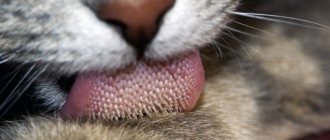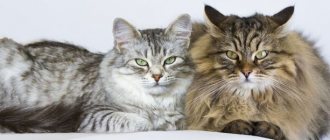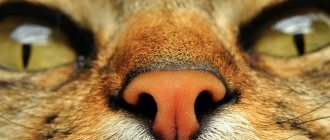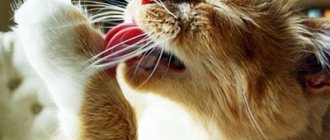What is the correct name for a mustache and why?
The scientific name of the mustache is vibrissae, translated from Latin, meaning “to wriggle”, “to oscillate”. If you look closely at the pet, you can see that they are really shaking. The cat's whisker follicles contain many nerve endings that capture air currents from objects and send information about the outside world to the animal's brain.
Interesting! Scientists have been able to establish that the mustaches of the ancestors of modern cats appeared earlier than the coat.
Cats without whiskers
What happens if a cat loses its whiskers? Usually owners cut them off on purpose or by accident. However, this is not recommended under any circumstances. Because of this, the pet will lose spatial orientation, begin to feel insecure, and constantly fear something. Accordingly, your mood will suffer.
However, it should be noted that the mustache will grow quite quickly. The hair on the face grows faster than the fur. But you should still take care of your pet without lowering his mood with deliberate or accidental actions.
After watching the video, you will learn in more detail about what cat whiskers are and what functions they are endowed with.
Features of whiskers in cats
Cats' whiskers grow from birth, and their structure does not depend on the gender and breed of the animal. The only difference is the length and thickness of the hairs.
Structure
Cat whiskers have an interesting structure. Their roots are located in tissues with nerve endings approaching the hair bursa of the vibrissae. Each cat's whisker is associated with a specific part of the brain and is responsible for the functioning of a specific system.
Length
On average, cats' whiskers grow to 5-7 cm. The length of the whiskers depends on the breed of the animal. Maine Coons are considered to have the longest mustaches. A representative of this breed, nicknamed Miss, is listed in the Guinness Book of Records due to whiskers of 20 cm. But the hairless Canadian Sphynxes have short whiskers or no whiskers at all.
On a note. Cornish Rex and Devon cats have curly whiskers. This structure of the vibrissae is due to the presence of a special gene.
Thickness
The thickness of a cat's whiskers depends on the number of nerve endings, which give rise to tubercles at the very base of the whiskers. It is influenced by the sex of the animal and the location of the hairs. The female's mustache is thinner than that of the male. And the vibrissae growing on the cheeks are thicker than those located above the eyes and on the front legs.
Locations
Contrary to popular belief, cats' whiskers do not only grow on their faces. Thickened long hairs are also found on other parts of the animal's body. But they differ in quality from those located on the muzzle.
Cats' whiskers grow:
- above the eyes;
- near the nose;
- on the chin;
- around the labial pads;
- on the front legs.
The vibrissae growing on the forelimbs are almost invisible. But if you wish, you can see them just above the place where the dewclaw is located.
Cat health
Both your pet's whiskers and fur have an expiration date. The cover wears out over time, losing strength and elasticity. It happens that the owner discovers a lost whisker of his precious pet and, headlong, runs to the veterinarian with questions. Most often, if one or two whiskers fall out, this is not a symptom of any disease: a new hair will simply grow in this place. In the same way, all other wool is replaced, and human hair is a natural process.
https://youtu.be/gFYUkUA8ewg
It is important to distinguish between a fallen cat whisker and a broken one. The fallen hair at the tip has a dense thickening, a bulb, but the tip of a broken mustache will be uneven and beveled.
A cat's whiskers can break for a variety of reasons. Most often, the old mustache ceases to be sufficiently elastic, after which it breaks off due to mechanical stress. However, if your pet's whiskers split, often break off, regularly fall out, or bend in different directions and do not straighten, you should visit a doctor. Maybe the cat has a deficiency of some element, or maybe it has an infectious disease.
What functions do whiskers perform in cats?
Vibrissae perform several important functions. A cat needs whiskers to:
- Orientate yourself in space, especially at dusk. Although cats see well in weak moonlight, sensitive vibrissae help them obtain additional information about objects nearby.
- Assess the dimensions of surrounding objects and the distance to them. Before crawling under the sofa, the cat will use its whiskers to check whether it can get there.
- Explore new things, people and animals. Using its whiskers, the cat receives information about unknown objects and objects.
- Protect your eyes. When a cat makes its way through the bushes in the dark, its hard whiskers come into contact with protruding branches and it instinctively lowers its eyelids.
- Find out about weather changes. With the help of their whiskers, cats sense the slightest changes in temperature and humidity. It is believed that they anticipate the approach of natural disasters.
- Calculate the trajectory of the jump. Using its whiskers, the cat determines the speed and direction of air currents. Thanks to this, she calculates how best to jump.
- Receive information about food. The cat uses its whiskers to check the freshness and temperature of the food.
- Determine the location of the prey. Using its whiskers, the cat detects the vibrations in the air created by the mouse's escape and knows how far away it is. And the vibrissae located on the front legs allow it to control the condition of the caught prey.
Prevention methods
In order for the cat to feel good, be healthy, please the owner’s eyes and not lose its whiskers, you need to take some preventive measures:
- Frequently ventilate and humidify the air in various ways.
- Monitor the quality of food, provide access to plenty of fresh and clean water.
- Treat your pet for parasites and get vaccinations in a timely manner.
- Do not trim the animal's whiskers.
- Do not give medications not prescribed by a veterinarian.
Vibrissae do not simply decorate a cat, but are part of a sense organ ; they allow the animal to be in comfortable conditions and help navigate, especially in the dark. Without them, a domestic cat will not die, but its quality of life will noticeably decrease, it will suffer and be stressed until new ones grow.
The pet may become frightened and absent-minded, and may also become angry at its owner or the child who “joked” like that, so you should not conduct experiments on the animal.
Cat's whisker tongue
Communication is the most important thing a cat's whiskers do. With the help of vibrissae, she gives signals by which her mood can be determined:
- If a cat's whiskers are directed forward towards the object of study, then the animal is friendly and ready to communicate.
- If a pet presses its whiskers, it means it is scared or angry. In this case, it is better to temporarily refuse to communicate with the animal, otherwise there is a risk of being harmed by its claws and teeth.
Interesting Facts
Owners who want to know why a cat needs a mustache will be interested in reading the following:
- the adult has approximately twenty-four whiskers;
- On average, a cat's whiskers are six to seven centimeters long;
- the Finnish cat had the longest whiskers - nineteen centimeters (he even got into the Guinness Book of Records);
- hairless cats have very short and curly whiskers, and it also happens that some hairless cats have no whiskers at all;
- Previously, people who firmly believed in omens believed that if you found a fallen cat’s whisker near the house and made a wish, it would definitely come true.
When scientists wanted to answer the question “ why do cats need whiskers ?”, they conducted a study: they removed several whiskers from kittens and began to track changes in their brains. As a result, it turned out that if the whisker did not grow, the part of the brain associated with it was replaced by the neighboring one. Such a complex process suggests that the whiskers are the most important feline organ, and should be treated with care and attention.
Is it possible to trim a cat's whiskers?
Trimming whiskers is strictly contraindicated. Without whiskers, it will be difficult for a cat to navigate in space. She will bump into various objects and fall while jumping. Also, without whiskers, a cat will not be able to move in the dark, and will use its paws to determine the temperature of food.
An animal with damaged whiskers should not be allowed outside. Left without a mustache, the cat will become fearful, insecure and defenseless.
On a note. In rare cases, veterinarians shave cats' whiskers to enhance the therapeutic effect. This is done to treat fungal diseases and in cases where the whiskers have grown so long that they cause discomfort to the animals.
The role of whiskers in the life of a cat
If the whiskers are trimmed, the cat will experience discomfort. The animal's perception of the world and orientation deteriorate. The brain does not receive enough necessary information about the world around it. The animal does not orient itself in space, gets stuck in passages, does not orient itself in the room, and often falls.
It is difficult for street animals without vibrissae, as they cannot fully hunt, experience problems with nutrition, and are easily injured. A cat without whiskers loses coordination, may fall from a height, and fail to calculate the jump.
Important: Under no circumstances should you trim your cat’s whiskers. Trimming the whiskers is permissible if the area of the skin on which they are located is infected in any way. The procedure is carried out by a veterinarian who has previously treated the area of skin.
Fortunately for cats, whiskers tend to grow back. This is only if the hair follicle is not damaged. Vibrissae change (fall out and grow again) in 2-3 weeks.
Why do mustaches break?
Don’t rush to panic if your pet’s whiskers sometimes break off.
Often this phenomenon is caused by hereditary factors. Representatives of some cat breeds, for example, Sphynxes, have whiskers that break at the behest of capricious nature.
The most common unnatural reasons are:
Lack of vitamins.
A state of vitamin deficiency is sometimes the root cause of why a cat's whiskers break. Other signs can help tell the owner that the purr is lacking some minerals:
- wool hairs fall off;
- claws look painful and brittle;
- a foul odor emanates from the mouth.
Often, pets suffer from a lack of taurine (due to the rare presence of meat products in the diet) and collagen, because they cannot get it on their own. A gradual decrease in collagen levels in a cat's body can lead to irreversible changes and may explain why a cat's whiskers break. Every professional breeder knows what to do when this problem is discovered. Special vitamin and mineral supplements allow you to constantly replenish the reserves of this precious element.
Unbalanced diet.
Another reason why a cat’s whiskers break off is the presence in the diet of foods unsuitable for animals, an overwhelming amount of fish, and cheap ready-made food. In the absence of other symptoms indicating serious illness, an incorrect feeding system may be the only explanation for the loss of whiskers.
Fungal infections.
A variety of fungi, penetrating into all layers of the skin, also affect the hair follicle, which becomes clogged, which prevents the mustache from germinating; or damage the structure of the vibrissa, which leads to its breaking off.
Infection with parasites and helminths.
The body throws all its strength into the fight against parasites. Forgotten mustaches break from lack of attention. Whisk eaters that have settled in their hair follicles often gnaw through the vibrissae.
The mustache also becomes brittle due to the proliferation of helminths in the body. Worms literally intercept beneficial nutrients on the way to the cat's organs, and they constantly poison and weaken the body in the process of their vital activity.
Sometimes pet lovers wonder why kittens' whiskers break off. The answer is simple: the antennae of all little furries break and fall out during adolescence. By consulting a veterinarian, you can help your pet get through this difficult time.
Expressing feelings
Another answer to why a cat needs a mustache is to determine the animal’s mood. By their direction, you can understand what the pet is in the mood for and about its well-being.
When the whiskers are pressed tightly to the muzzle, it means that the cat is clearly embittered and may show aggression. If the whiskers are directed forward, then the cat is curious and interested in something. When a pet is dozing or in an affectionate mood, they are relaxed and fluffy.
Why does a cat need a mustache? Research and experiments by veterinarians show that if an animal is deprived of them for any reason, it can get sick and even suffer from mental disorders. Indeed, in this case, the pet loses the ability to receive and process a lot of information coming from the outside.
Many owners note that if a cat loses its long whiskers, it becomes lost and its behavior changes. The animal becomes irritable or aggressive.
Mustache care
There are no special mustache care procedures. The place where they fall out or break does not need to be processed, as well as any other procedures. However, there are a number of manipulations that definitely should not be done.
Do not pull out, break or trim your mustache. Even if there is a suspicion that they are too long or the cat is uncomfortable walking with them, removing the whiskers and violating their integrity is prohibited. In addition, the rule that if you trim the whiskers, they will grow longer in the future - this is fundamentally wrong.
The loss of 1-2 antennae is not dangerous for a kitten and is natural. In other cases, you should take a careful look at the animal and try to find the reason for the massive loss of its senses of touch. If there are accompanying symptoms, as well as suspicions of the presence of disease or parasites, you should consult a veterinarian. An examination and tests will help identify the cause of the loss or deterioration of the kitten’s whiskers.
A cat portrait is unthinkable without whiskers (vibrissae). Long and stiff hairs fan out in different directions, are usually colored to match the color of the coat and serve not only as a characteristic decoration, but also as an organ of skin touch. Sometimes it happens that a cat loses its whiskers for one reason or another. What causes the breaking and loss of vibrissae? How safe is this for the animal? And what needs to be done to ensure that your furry pet always remains mustachioed?
How to help an animal that has lost its whiskers
Regular whisker loss in cats without an identified cause requires additional examination by a veterinarian. After receiving the results, appropriate treatment methods can be carried out:
- taking anthelmintic and antiparasitic drugs for therapeutic and preventive purposes;
- antihistamines to eliminate allergies and antibiotics to treat infectious diseases;
- vitamins, minerals to strengthen and restore immunity.
Creating favorable living conditions for your pet:
- eliminating excessive dryness in the room when using a humidifier;
- ensuring that bathing is not too frequent and using special shampoos;
- the use of fatty acids (biotin, taurine) in compliance with the dosages prescribed by the veterinarian, since an excess amount of drugs can have the opposite effect;
- eliminating stress factors for your pet;
- use of high-quality animal feed;
- ensuring water balance (regular fluid intake by the cat throughout the day).
Recommendations for eliminating this problem if your cat’s whiskers fall out for various reasons:
- using cheap food for the animal, since such products are of poor quality and can negatively affect the general condition of the pet;
- regular treatment of the coat against parasites, fleas and ticks;
- processing raw meat to destroy helminth eggs that may be contained in it;
- excluding aggression towards the cat from other family members (young children);
- addition of various vitamin complexes to the daily diet of cats;
- regularly providing the required amount of drinking water for the animal, since its lack contributes to the development of urolithiasis and other problems;
- visit the veterinarian at least 2 times a year to assess the general condition of the pet;
- excluding the trimming of whiskers in cats, since even a slight shortening of the length can cause the development of negative consequences.
Whiskers for cats are one of the important organs that provide touch, so their damage becomes the cause of many disorders in the body. Vibrissae require careful care and control on the part of the pet owner to maintain the good condition of the animal.
Treatment
First of all, you should contact your veterinarian. Having discovered the causes of the illness, the doctor will prescribe medications to eliminate the problem and restore the mustache, fur and other organs.
If the illness was caused by food, then the cat should be put on a diet, excluding from the diet foods that interfere with the normal functioning of the pet’s body.
Whiskers fall out from external allergens. You should get rid of them immediately. If it is shampoo, replace it with simple soap and rinse in chamomile baths. If the bed the cat sleeps on, then replace it with another one made from natural fabric. Places on the body affected by allergies should be wiped with special antiseptic tinctures or decoctions.
If endocrine functions are disrupted, causing vibrissae loss, drug treatment and a special diet will help.
A pet must not only be kept at home, but also cared for
Pay attention to his behavior, health status and feed him well. Also, carry out hygiene procedures and visit a doctor
It is always worth remembering that a person is responsible for the one he tames.











